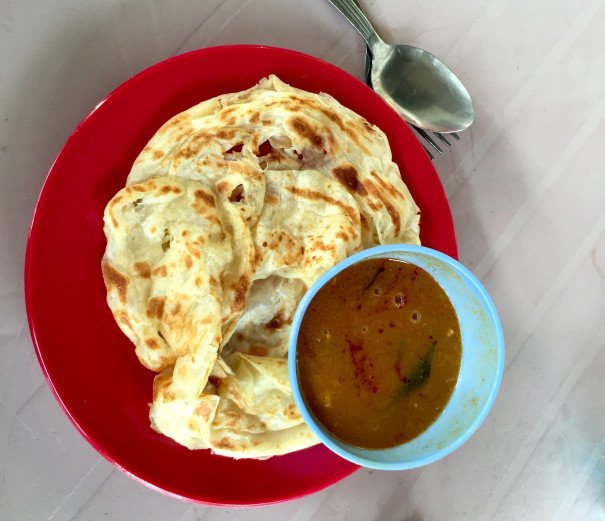
A Breakfaster First and a Traveler Second

A Breakfaster First and a Traveler Second
Roti in Kuala Lumpur
The roti man was both an abuser and a creator. In his ancient storefront, he pulverized the dough, stretched the dough, pulled the dough, and, finally, when it was stretched thin and face-sized, he let it brown and crisp on his griddle.
Middle-aged and black-mustached, the cook was the master roti maker of Kuala Lumpur’s Old Train Station. At least that is what it appeared to me, a clueless wanderer and first timer in this historic landmark; a newbie to the whole city, for that matter. And here I was, leaving on my second day for greener, less populated pastures: Penang, an island four hours north by bullet train.
“My train leaves in twenty minutes,” I said to the roti man as a sort of passive warning. I was running late but the roti had trapped me. It did not faze him.
“No problem sir. Something to drink? Coffee? Iced. Yes, sir. Please sit, sir.”
I did as the roti man said. I am a breakfaster first and traveler second.
At 9 am, the open-air dining area was moderately full, Malays and Indians sitting alone or in groups, commuters and travelers all of them, because we were in a train station.
There was the roar of the trains coming and going below and, periodically, a stream of passengers—Malays, Tamils, Indians, Han Chinese, Hakka Chinese, the whole Malaysian rainbow—passing through the ticket gate, which was right there by my table.
I approached the dark-skinned, mustached Indian ticket attendant, a Hulk. I handed him my ticket. With the clock ticking and the roti cooking, I needed reassurance that I was in the right place.
“Coming just on that platform, sir,” he said and pointed one barrel-sized arm down the stairs. I looked at my watch. Ten minutes to arrival.
My iced coffee came as soon as I sat back down, Malay style, white coffee, made with robusta beans roasted in butter and delivered to me by a man with a tough face in a tropical island shirt. I sipped it through a straw as I took in the surrounds. One hundred and six years old, the station is a marvel of colonial architecture.
The station is white and airy, with diamond cutout window patterns and Mughal-inspired spires, a masterful melding of east and west. Through the windows, I could see to the abandoned tracks below overgrown with grass and other weeds, with rusty, hulking lorries waiting in vain for their next ride.
My roti arrived, perfectly charred and with a small bowl of dipping sauce, a chili curry with chicken bits and bay leaves. I tore apart the roti with a fork and spoon, using the spoon as a knife. Pain from the chili woke me up just as much as the caffeine.
Fifty cents later, I am walking past the Hulk and down to my platform through the ancient station. The train was punctual, a giant white snake, new to this world and looking suspiciously out of place in this fading vestige of colonialism. It was part of the new Malaysia: efficient, shiny, and right on time. I stepped inside, into a brave new world of AC, plush seats, and sliding-glass doors opened with a button. My stomach full and mouth burning, I was off to Penang at high speed.